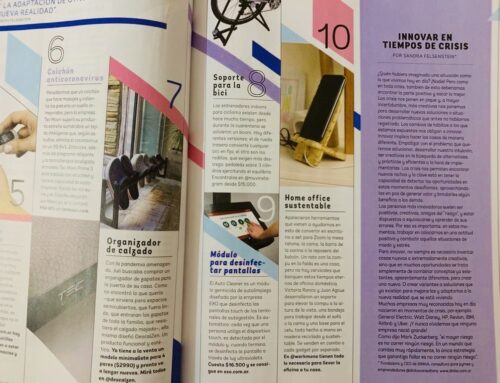
Export of microenterprises.
He worked in a consultant and financial. He learned everything necessary and threw himself on his own. With 27 years, Sandra Felsenstein saw a niche that took her to the pages of the prestigious Financial Times.
For years, an athlete embraced recognition not only when a medal was hung around the neck but also when his face became the cover of the magazine El Graphic. A milestone that, in addition to resembling a caress to the ego, was almost a well -undertaking confirmation. The same, although in the business world, it happened- and happens- for those entrepreneurs who manage to bear their name and history to the pages of the Financial Times, one of the most important and influential economic newspapers in the world. This can boast Sandra Felsenstein, a 27 -year -old industrial engineer who created Dinka, a firm that is responsible for a small group of designers and artisans to achieve, in exchange for a commission on sales, which can open markets abroad for their contemporary jewelry products, accessories and clothing.
"This was a niche, something that nobody was doing. Exporters are interested in other products, with high profitability and large quantities. And designers want their products to be outside, but they want to avoid - for fear of getting involved in a tax or legal problem or for promising something that they can not fulfill - all that part that involves exporting and commercialization. Felsenstein explains to Clarín.com.
It happens that the 30 suppliers with which even works are unipersonal or three and three people, at most. And there are no government entities that also take care of that? "There are, but they do not do all the work. The price, the shipment, the search for customers, the artisan has to be done. A little that's why the company arose," replies the former financial employee Johnson & Johson.
Since its creation, a year ago, the firm achieved sales for 20 thousand dollars and that the pool of artisans penetrated in Peru, Ecuador and Chile. "Now we are starting to work more with the United States, where we reach an agreement with a retail distributor in Texas. The goal for this year is to reach Europe," he adds, while ensuring that "Argentina is considered a country with very good design, of original creations."
With regard to the obstacles he faces, Sandra Felsenstein affirms that "a lot of marketing is necessary. Advertising a brand in Europe has other costs. It also implies trips, stays and parades to meet customers. Like any investment, at first it is complicated." In spite of everything, the young businesswoman dreams that in the coming years the billing reaches one hundred thousand dollars.
To your suppliers, do you encourage them to produce what you ask you or what do you think can be better?
The important thing is to maintain the essence of each designer. As they are works of art, they have to be born from who is doing them. Sometimes we advise you, if you ask for the variation of a piece or if you like a material somewhere, do you. But we do not change the style of each jeweler or designer. Yes, we are looking for, within how artisanal it is, standardize them a little to simplify the order and to be repeated.
What makes you think that thirty is the ideal number of suppliers?
I do not know if it is the ideal number, but for now, it is a good number and it is the one we can handle. The idea is not to create a mega company overnight because that is when problems arise. It seems to me that we are in a number that allows us to have a wide offer, without overflowing. We are 4 people: a capitalist partner and two other people who work but are not associated.
Is the production cost lower here than in other countries?
Definitely. In Europe they look for us to have a good design and at an affordable price. In Latin America we are not so accessible, but there are customers who can face it because they see us as an extraordinary design site.
Were you not quieter, with fewer problems, in the financial or in the consultant where you worked?
I was always interested in having my own venture. When thinking about the industries that I like, such as design and fashion, I realized that there was a niche and it seemed good to join without being designing. And so I began to coordinate a whole group of designers from the commercial and financial part, which is the most known.








